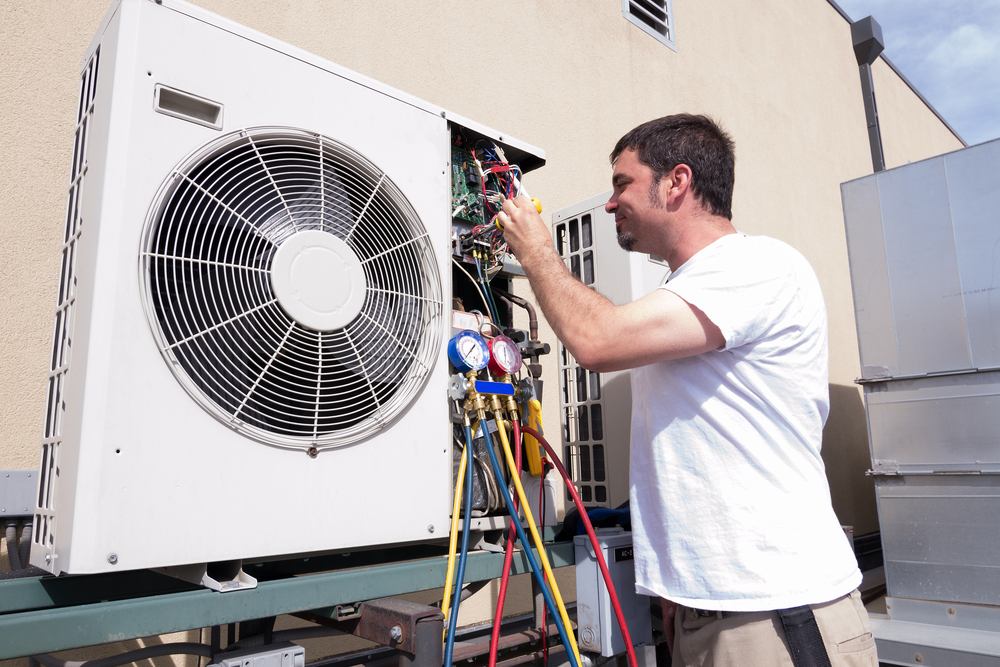Garages are notoriously unforgiving during the winter months. Because they aren’t considered living spaces, they don’t adhere to the same building codes as living and interior rooms. Aside from being unpleasant, a cold garage can do real damage to your car batteries and anything you have stored. For example, aerosols like WD-40 can crack, malfunction, or explode due to the temperatures.
Heating your garage prevents this but also helps reduce the amount of energy required to heat the rest of your home.
So if you’re facing frigid temperatures and asking how can I keep my garage warm in winter? These five tips are for you.
Install a Forced Air Heating Unit
First up, we have forced air. Installing a forced-air unit may be an excellent option for you because it can be integrated into your existing home system. However, some systems work independently.
Forced air units work by blowing air over a heating element, forcing the hot air into the room. Homeowners who use their garages as a hobby space enjoy these heating units because they quickly warm up the area. The only drawback is that you risk blowing it everywhere if you are doing work that produces sawdust or other solid by-products.
Invest In a Ductless Heating System
Ductless heating systems are popular options for their convenience. You get the benefits of central heating and cooling without needing the entire system. Some models even allow you to control them with remotes, wall thermostats, and apps.
A ductless system works by drawing in air from the outside. It requires cutting a hole into the wall to place the unit, so it’s not the most DIY-friendly project. An HVAC technician or electrician may be needed to ensure proper installation.

Insulate Your Garage
Insulating your garage is one of the easiest ways to raise the temperature. While you may still need a heating source, it helps to make your garage far more comfortable.
The type of insulation your need depends on your home. Fiberglass is the most widely available insulation and the most popular choice. While spray insulation is very effective (and cool to use), it’s more challenging to get right on your own.
Also, the age of your home will determine the size of the insulation you use. Older homes typically use 2×4 wall studs for vertical framing, while newer homes use 2×6.
Seal Up Those Drafts
Before installing insulation, seal up any cracks, holes, and gaps. Not only will this prevent water and weather invasion, but you also avoid insects and rodents moving in during the winter. An expanding sealant will help you close up those cracks with more precision. Choose a waterproof option and a caulking gun for the best results and always follow the manufacturer’s directions.
Install an Insulated Garage Door
Insulated garage doors are a great addition to weatherproofed and insulated garages. It keeps your garage 12 degrees warmer in the winter and 25 degrees cooler in the summer.
Some homeowners choose to add insulation to uninsulated garage doors, but this is dangerous. Garages are 130lb moving walls. Adding things like insulation that sticks to it can prevent your door from functioning correctly. We recommend avoiding this particular DIY and opting for an insulated garage door from the professionals.
Insulated doors are double-walled with an inner foam core to prevent heat and cold loss. Read up on the Top Six Best Insulated Residential Garage Doors before purchasing to ensure you’re finding the best option.
Add Radiant Heating
Radiant heating uses infrared technology to heat things through convection. This means heat is transferred to you by touch. So in your garage, the temper gradually rises because everything else is warming up. The most popular types of radiant heat are hydronic and electric.
Hydronic heat is the most popular and cost-effective option. Heated water is pumped through tubes built into your floor, wall, or ceiling panels. With electric radiant heating, electric cables are used instead of tubing. Electric radiant heating is the best option for a garage’s large area and concrete floor.
For heating your garage, go with the best option that fits your budget while fulfilling your heating needs. However, if your garage door is the source of the problem, you’ll likely lose more energy and money trying to heat your space. We can help. We’ve been serving the Denver, Colorado area for more than 35 years, and there’s no garage door problem we can’t solve. Contact us today for all your garage door concerns.
Recent Posts
Archives
- November 2024
- October 2024
- September 2024
- August 2024
- July 2024
- June 2024
- May 2024
- March 2024
- February 2024
- December 2023
- November 2023
- October 2023
- September 2023
- August 2023
- July 2023
- May 2023
- April 2023
- March 2023
- January 2023
- December 2022
- October 2022
- September 2022
- August 2022
- July 2022
- June 2022
- April 2022
- March 2022
- February 2022
- January 2022
- December 2021
- November 2021
- October 2021
- September 2021
- August 2021
- July 2021
- June 2021
- May 2021
- April 2021
- March 2021
- February 2021
- January 2021
- December 2020
- November 2020
- October 2020
- September 2020
- August 2020
- September 2017
- August 2017
- July 2017
- June 2017
- May 2017
- February 2017
- January 2017
- December 2016
- November 2016
- October 2016
- September 2016
- July 2016
- June 2016
- May 2016
- April 2016
- January 2014
- November 2013
- September 2013
- March 2013
- February 2013
- January 2013
- December 2012
- November 2012
- October 2012
- September 2012

Recent Comments